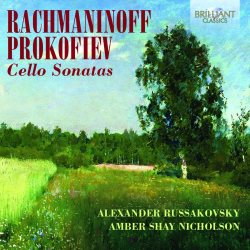|

|
Sergei RACHMANINOV (1873-1943)
Cello Sonata in G minor Op.19 [37:05]
Pyotr Ilyich TCHAIKOVSKY (1840-1893)
Pas d’action: Andante cantabile from Act II of Sleeping Beauty Op.66
(arranged for cello and piano by Albert Kleineke [4:20]
Alexander GLAZUNOV (1865-1936)
Sérénade espagnole [2:46]
Sergei PROKOFIEV (1891-1953)
Cello Sonata in C Op.119 [25:20]
Alexander Russakovsky (cello); Amber Shay Nicholson (piano)
rec. 29-30 May 2012, Rosch Recital Hall, SUNY Fredonia, New York, USA
BRILLIANT CLASSICS 94771 [68:56]
There is something particularly satisfying about the juxtaposition of a cello with a piano, like a man and a woman, with the cello’s deep and rich tones set alongside the piano’s bright singing voice. In the hands of the quintessentially romantic Rachmaninov the mix is irresistibly powerful. Premièred on 2 December 1901, the Cello Sonata came after the crushing failure of his First Symphony, his Op.13, at its première in 1897. The failure was due in no small way to the lack of rehearsal and poor performance by the conductor, Alexander Glazunov. Its second performance did not take place until October 1945 since when it has gained its deserved place in the repertoire of most orchestras. The success of the Cello Sonata along with his Second Piano Concerto restored Rachmaninov’s self belief though the symphony’s reception continued to haunt him. The Cello Sonata abounds in the most gorgeous melodies and the opening movement introduces one of the most heart-rending of all his huge total of such tunes. The second movement is lighter in tone though with a spirited beginning and end. The third movement is again dominated by another of Rachmaninov’s ravishingly beautiful tunes for which he had such an obvious facility. The finale recalls the sonata’s opening theme presented as a decorative element having been stripped of its plaintive edge.
Tchaikovsky’s Andante cantabile from his ballet Sleeping Beauty in a version by Albert Kleineke, the overseer of all Tchaikovsky’s compositions at his publisher’s, is a wonderful vehicle for the duo of cello and piano. It emphasises its deliciously lyrical nature, delivering four minutes of pure joy.
It has often been said that the best ‘Spanish’ music has been written by thosae who are not Spanish though that is grossly unfair to composers such as Albeniz, de Falla, and Rodrigo. However, it is true to say that Spain, with its warmth both of temperature and temperament as well as the excitement of its folk rhythms and dances, inspired many to create music that was entirely convincing in its evocation of that colourful country, even by some who never set foot in it. Ravel, Debussy, Chabrier, Rimsky-Korsakov and Glinka were just some who were driven to write music that conjured up the Spain of their imagination. Glazunov’s short Sérénade espagnole is a case in point, inspired as it was by a visit he made to Spain in 1884. Originally scored for cello and orchestra it works equally well in this version. It brings to mind a dancer with castanets accompanied by a guitarist in a spirited and passionate display on the dance floor.
In a review of a disc featuring piano concertos by Rachmaninov and Prokofiev I remarked how much of a world away the Prokofiev was in comparison with the Rachmaninov. The same cannot be said of the two cello sonatas. Whereas the piano concertos were written with an intervening gap of only twelve years these two works are separated by almost fifty years. Prokofiev’s sonata dates from 1949 but while his piano concerto will have sounded breathtakingly modern to audiences back in 1912 the cello sonata will not have had anything like the same impact. The modernism of his music would have sounded much more ‘normal’ in the post war era. If anything the passage of time had mellowed Prokofiev’s music and the Cello Sonata is much more gently ‘classical’ than the spiky rather brittle sounding music of his youth. There is considerable warmth about the music here even in its more austere moments as in its opening movement. The second movement is more like the Prokofiev we know with echoes of his Romeo and Juliet at the outset. The central theme is attractively romantic in character. A gentle waltz emerges out of the spirited opening before reverting to the burlesque-like atmosphere of its beginning. The third and final movement begins energetically enough then subsides into a restrained passage before moving towards a triumphal conclusion redolent of the ringing of bells.
These two wonderful cello sonatas are in extremely good hands here with the warmth of Alexander Russakovky’s beautiful cello matched by the expressively bright playing of Amber Shay Nicholson. The two ‘fillers’ are delightful in their own right.
Steve Arloff
 |
 |
|
